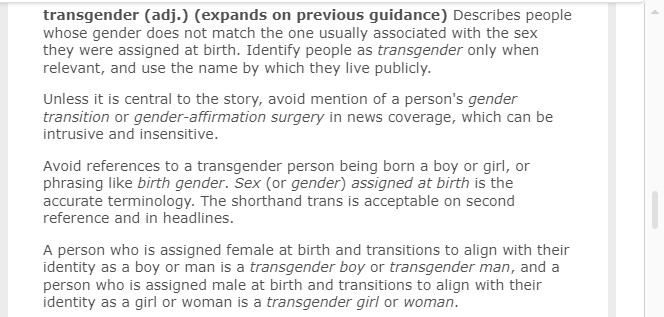
Changes to the Associated Press Style Guide direct reporters to avoid mentioning biological sex in favor of the term “sex assigned at birth.”
“Avoid references to a transgender person being born a boy or girl, or phrasing like birth gender,” reads a new entry to the guide, announced at the Society for Editing conference on March 23. “Sex (or gender) assigned at birth is the accurate terminology.”
According to the updated guides, someone “assigned female at birth” who identifies as a male is a transgender man, while a person “assigned male at birth” but who identifies as a female should be called a “transgender girl or woman.”
The guide forbids journalists from calling a person “a transgender,” or using the terms “transgendered” or “transgenderism.”
The new transgenderism guidelines expand on AP’s existing definition of transgender: “Describes people whose gender does not match the one usually associated with the sex they were assigned at birth.”

The Associated Press is the most common stylebook among journalists and news outlets on the Left and Right, including The Daily Signal. The Daily Signal does depart from AP style when the style guide adopts partisan messaging on abortion, transgender identity, and other issues, however.
The Associated Press did not respond to The Daily Signal’s request for comment.
The new entries also include sharper prohibitions on so-called “deadnaming” and a new definition of “queer.”
Deadnaming, according to the abridged definition, is the “widely considered insensitive, offensive or damaging” practice of “referring to transgender people who have changed their name by the name they used before their transition.”
“Deadnaming a transgender person, even posthumously in obituaries or other coverage, is often considered disrespectful to the deceased, their survivors and any transgender people,” the guide says.
The Associated Press even directs journalists to acknowledge the transgender identity of criminal suspects. The new entry urges them to consider that authorities or family members may disregard the suspects’ wishes regarding their name and pronouns, so journalists must consider information from the person or others with “better” information about “how the person lived and identified.”
The New York Times presumably adopted AP’s changes, tweeting an apology for referring to the biological female shooter who killed six people at a Nashville Christian school by “she” and “her” pronouns though she appeared to “identify as a man.”
The Associated Press also expanded its definition of gender non-conforming to include the meaning of “gender-expansive,” a similar term that “carries a connotation of flexibility and exploration of one’s gender identity.”
A new definition of queer also joined the style guide’s ranks. The entry differentiates from using queer as a term of “empowerment” and a “slur.”
“The term sometimes is used as a synonym for LGBTQ+. However, because of its origins as a slur, queer is not universally accepted among LGBTQ+ people, and its use tends to be more prevalent among younger generations,” the guide reads.
The guidelines represent ideology masquerading as a style guide, according to Jay Richards, director of the DeVos Center for Life, Religion, and Family at The Heritage Foundation. (The Daily Signal is The Heritage Foundation’s multi-media outlet).
“The terms ‘sex,’ ‘male,’ and ‘female’ refer to empirical, firmly established biological facts. For the AP, however, these terms are off-limits,” Richards told The Daily Signal.
He said the AP categorizes the division between “male” and “female” as not “accurate” because the news agency subscribes to radical gender ideology, which reduces sex to a social construct.
“What this means is that any discerning reader will henceforth question the accuracy and coherence of any AP story related to the gender controversy,” Richards said.
Have an opinion about this article? To sound off, please email letters@DailySignal.com and we’ll consider publishing your edited remarks in our regular “We Hear You” feature. Remember to include the url or headline of the article plus your name and town and/or state.

Be the first to comment